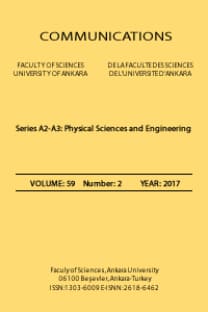SENTIMENT ANALYSIS USING A RANDOM FOREST CLASSIFIER ON TURKISH WEB COMMENTS
Sentiment Analysis, Word2Vec, Random Forest, Turkish Web Comments
___
Wiebe, J. “Learning Subjective Adjectives from Corpora”, Proceedings of the Seventeenth National Conference on Artificial Intelligence and Twelfth Conference on Innovative Applications of Artificial Intelligence, July 30- August 03 (2000): 735-740.Das, S.R. and Chen, M. Y. 2001. “Yahoo! for Amazon: Extracting Market Sentiment from Stock Message Boards”. In Proceedings of the 8th Asia Pacific Finance Association Annual Conference, (2001).
Morinaga, S., Yamanishi, K., Tateishi, K. and Fukushima, T. “Mining Product Reputations on the Web”. In Proceedings of ACM SIGKDD International Conference on Knowledge Discovery and Data Mining, (2002).
Tong, R. M. “An Operational System for Detecting and Tracking Opinions in On-Line Discussion”. In Proceedings of SIGIR Workshop on Operational Text Classification, (2001).
Pang, B., Lee, L. and Vaithyanathan. S. “Thumbs up? Sentiment Classification Using Machine Learning Techniques”. In Proceedings of the Conference on Empirical Methods in Natural Language Processing (EMNLP), (2002): 79–86.
Turney, P. 2002, “Thumbs Up or Thumbs Down? Semantic Orientation Applied to Unsupervised Classification of Reviews”. In Proceedings of the 40th Annual Meeting of the Association for Computational Linguistics, (2002): 417–424.
Nasukawa, T. and Yi, Jeonghee. “Sentiment analysis: Capturing Favorability Using Natural Language Processing”. In Proceedings of the KCAP-03, 2nd Intl. Conf. on Knowledge Capture, (2003).
Bollen, J., Mao, H. and Zeng, X. 2010. “Twitter Mood Predicts the Stock Market”. Journal of Computational Science, (2010): 2(1), 1–8.
Kim, Y., Jernite, Y., Sontag, D. and Rush, A. “Character-Aware Neural Language Models”. Proceedings of the Thirtieth AAAI Conference on Artificial Intelligence (AAAI-16), (2016).
Zhang, X., Zhao, J. and LeCun, Y. “Character-level Convolutional Networks for Text Classification”. In Proceedings of NIPS, (2015).
Mikolov, T., Sutskever, I., Chen, K., Corrado, G., and Dean, J. “Distributed Representations of Words and Phrases and their Compositionality”. In Proceedings of NIPS, (2013).
Pennington, J., Socher, R., and Manning, C. D. 2014. “Glove: Global Vectors for Word Representation”. Proceedings of the Empiricial Methods in Natural Language Processing (EMNLP), (2014): 12.
Bojanowski, P., Grave, E., Joulin, A. and Mikolov, T. “Enriching Word Vectors with Subword Information”. arXiv preprint, (2016): 1607.04606.
Camacho-Collados, J. and Pilehvar, M.T. “On the Role of Text Preprocessing in Neural Network Architectures: An Evaluation Study on Text Categorization and Sentiment Analysis”. arXiv preprint, (2017): 1707.01780
Lan, M., Zhang, Z., Lu, Y., and Wu, J. 2016. “Three Convolutional Neural Network-Based Models for Learning Sentiment Word Vectors towards Sentiment Analysis”. In Proceedings of the 2016 International Joint Conference on Neural Networks (IJCNN-16), (2016): 3172-3179.
Tang, D., Wei, F., Qin, B., Yang, N., Liu, T., and Zhou, M. 2016. “Sentiment Embeddings with Applications to Sentiment Analysis”. IEEE Trans. Knowl. Data Eng., (2015): 28 (2), 496-509.
Yu, L.-C., Wang J., Lai, K. R. and Zhang X. “Refining Word Embeddings for Sentiment Analysis”. In Proceedings of the Conference on Empirical Methods in Natural Language Processing, (2017): 545-550.
- ISSN: 1303-6009
- Yayın Aralığı: Yılda 2 Sayı
- Başlangıç: 2019
- Yayıncı: Ankara Üniversitesi
INTERPOLATION METHODS FOR RECOVERING THE SAMPLING VALUES OF GPR DATA
Entropy squeezing of a multi-photon Jaynes-Cummings atom in the presence of noise
3D VISUALIZATION APPROACH TO GPR DATA
SENTIMENT ANALYSIS USING A RANDOM FOREST CLASSIFIER ON TURKISH WEB COMMENTS
Nergis PERVAN, Hacer YALIM KELEŞ
A NEW SIMILARITY COEFFICIENT FOR A COLLABORATIVE FILTERING ALGORITHM
Ozge MERCANOGLU SINCAN, Zeynep YILDIRIM
Ozge MERCANOGLU SINCAN, Hacer YALIM KELES, Yagmur KIR, Adnan KUSMAN, Bora BASKAK
DETECTION OF MUSCLE FATIGUE: RELATIVE STUDY WITH DIFFERENT METHODS
